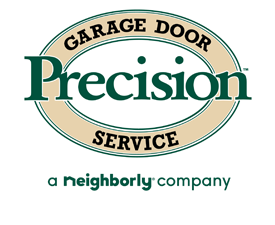Top 4 Signs Your Garage Door is Unbalanced
An unbalanced garage door can be a major problem for your garage door opener, and its unpredictable behavior can be a danger to those who regularly use the door.
To help you recognize the signs of an unbalanced door and safely perform your own at-home balance test, Precision Garage Door of Delaware put together the following troubleshooting post for our local homeowners in Delaware and North Maryland.
What is Garage Door Balance?
To understand what to look for in an unbalanced door, first you have to understand the concept of door balance and understand how to balance a garage door.
In a garage door that’s balanced, its weight is evenly managed by the tension of the system’s springs, making the opener’s job of leading the door up and down the track easy. Think of this as lifting weights you feel comfortable pressing, say 5 to 10 pounds.
In a garage door that’s considered unbalanced, either the springs aren’t providing enough tension to counterbalance the weight of the door or they’re exerting too much. Either way, added strain gets placed on the opener. If left without the attention of a professional for an extended period of time, an unbalanced door could cause the opener to fail prematurely or a cable or spring to snap.
You can compare this to lifting weights that exceed your comfortable lift limit. After some time, your muscles will get exhausted and ultimately give up.
Identifying Unbalanced Door Behavior
Keeping an eye on your garage door’s performance is the easiest way to make sure that everything is operating as it should. Here are some symptoms of an unbalanced door to watch out for:
- Garage door looks uneven while opening or closing: If your garage door looks uneven while it’s opening or closing and appears slanted, there’s a good chance that it’s out of balance. This is a very visual representation of the internal struggle happening inside your garage door’s system. The correct amount of power isn’t being transferred to all parts of the door, causing one side to be higher than the other.
- Garage door makes strange sounds when opening or closing: A balanced garage door should be relatively quiet when traveling up or down the door tracks. Added strain on the opener can cause an unbalanced door to be noisy as it fights to raise or close the door.
- Garage door takes longer to open or close: Without the correct amount of push or pull to move the door, an unbalanced door tends to take noticeably longer to open or close when you push your garage door remote.
- Garage door won’t open: When your unbalanced door becomes very unbalanced, the door may become too heavy for the opener to move at all and you’ll be stuck with a door that won’t budge.
Performing Your Own At-Home Balance Test
The best way to identify an unbalanced garage door is to perform a balance test. Because balance can shift over time and with heavy use, you should check your door seasonally to make sure it’s operating with the right balance.
Check out these steps to performing your own at-home balance test:
Step 1: Close the door from inside the garage.
Step 2: Detach the door from the opener.
- For a belt- or chain-driven opener that operates on a square rail or screw-driven opener, pull the manual release rope straight down.
- For a belt- or chain-driven opener that uses a T-shaped rail, pull the manual release rope straight down and back toward the motor unit.
Step 3: Move the door manually open and closed.
- It should move freely. If the door sticks, apply lubrication to the rollers and hinges as indicated in your owner’s manual. If this doesn’t correct the issue, or the door is too heavy to move, seek the help of a garage door professional.
Step 4: Lift the door by hand to the halfway point and carefully release it.
- The door should remain in place, supported by the springs. There may be gentle movement in one direction or the other.
- If it slams shut or opens forcefully, the door is out of balance.
Step 5: If the tested door is balanced, reattach the door to the opener.
- If you have a belt- or chain-driven opener that operates on a square rail or screw-driven opener, pull the manual release rope down and back toward the motor unit.
- If you have a belt or chain driven opener that uses a T-shaped rail, pull the manual release rope straight down and activate the opener. Your door will reconnect automatically.
What to Do if Your Door Fails the Balance Test
Adjusting your garage door springs is tricky and highly dangerous if you aren’t a trained and certified professional. If your door fails the balance test, promptly call a garage door technician you trust for help.
If you’re a Delaware or North Maryland homeowner whose door has failed the balance test, call Precision Garage Door of Delaware. Our technicians are certified by the International Door Association and know exactly what to do to get your door back in balance and back to working like it should.
At Precision Garage Door of Delaware, the safety of you and your family is our number one priority. Our technicians perform a comprehensive safety inspection on every visit, and offer emergency repairs 24/7, so you never have to wait long for your door to get the proper care it needs.
